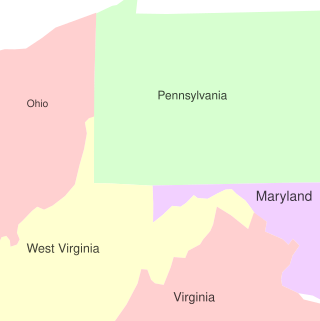
GenOn Energy, Inc., based in Houston, Texas, United States, is energy company that provides electricity to wholesale customers in the United States. The company is one of the largest independent power producers in the nation with more than 7,000 megawatts of power generation capacity across the United States using natural gas, fuel oil and coal. GenOn Energy was headquartered in the Reliant Energy Plaza in Downtown Houston. The company, formerly known as RRI Energy, acquired Mirant on December 3, 2010. The corporate names and logos of both RRI Energy and Mirant were retired.

American Electric Power Company, Inc. (AEP), is an America] domestic electric utility company in the United States. It is one of the largest electric utility companies in the country, with more than five million customers in 11 states.

Duke Energy Corporation is an American electric power and natural gas holding company headquartered in Charlotte, North Carolina.

TECO Energy Inc. is an energy-related holding company based in Tampa, Florida, and a subsidiary of Emera Incorporated. TECO Energy has several subsidiaries: Tampa Electric, which provides electricity to the Tampa Bay Area and parts of Central Florida; Peoples Gas Company, which provides natural gas throughout Florida; and TECO Services, which provides IT, HR, legal, facilities, and other services to current and former TECO subsidiaries. Previously the company was in the S&P 500 before it became private due its acquisition by Emera.
GenOn Energy Holdings, formerly Mirant Corporation, was a subsidiary of GenOn Energy, and is now a part of NRG Energy.
Cinergy Corp. was an energy company based in Cincinnati, Ohio, United States, from 1994 to 2006. Its name is a play on the words "synergy", "energy", and "Cincinnati".

Exelon Corporation is a public utility headquartered in Chicago, and incorporated in Pennsylvania. Exelon is the largest electric parent company in the United States by revenue and is the largest regulated electric utility in the United States with approximately 10 million customers. The company is ranked 99th on the Fortune 500.

FirstEnergy Corp. is an electric utility headquartered in Akron, Ohio. It was established when Ohio Edison merged with Centerior Energy in 1997. Its subsidiaries and affiliates are involved in the distribution, transmission, and generation of electricity, as well as energy management and other energy-related services. Its ten electric utility operating companies comprise one of the United States' largest investor-owned utilities, based on serving 6 million customers within a 65,000-square-mile (170,000 km2) area of Ohio, Pennsylvania, West Virginia, Virginia, Maryland, New Jersey, and New York. Its generation subsidiaries control more than 16,000 megawatts of capacity, and its distribution lines span over 194,000 miles. In 2018, FirstEnergy ranked 219 on the Fortune 500 list of the largest public corporations in the United States by revenue.

Allegheny Energy was an electric utility headquartered in Greensburg, Pennsylvania. It owned and operated electric generation facilities and delivered electric services to customers in Pennsylvania, West Virginia, Maryland, and Virginia. Allegheny Energy was incorporated in Maryland in 1925 as West Penn Electric Company. One of its predecessor companies dates back to the formation of West Penn Power on January 31, 1907.

Ameren Corporation is an American power company created December 31, 1997, by the merger of St. Louis, Missouri's Union Electric Company and the neighboring Central Illinois Public Service Company of Springfield, Illinois. It is now a holding company for several power companies and energy companies. The company is based in St. Louis, with 2.4 million electric, and 900,000 natural gas customers across 64,000 square miles in central and eastern Missouri and the southern four-fifths of Illinois by area.

The Crystal River Energy Complex consists of seven power-generating plants on a 4,700-acre (1,900 ha) site near the mouth of the Crystal River in Citrus County, Florida. Crystal River 1, 2, 4, and 5 are fossil fuel power plants. Crystal River 3 was previously the sole nuclear power plant on the site (1977-2013). The Crystal River Combined Cycle site consists of two Mitsubishi gas turbines, which came on-line in 2018. The complex was developed in the early 1960s by the Florida Power Corporation and sold to Progress Energy Inc in 2000. Following Progress Energy's merger with Duke Energy in 2012, the facility is owned and operated by Duke Energy.
Carolina Power & Light (CP&L), later doing business as Progress Energy Inc., was an electrical generation, transmission, and distribution utility based in Raleigh, North Carolina. The company was founded on July 13, 1908 as the result of the merger and buyout of numerous small, private, and financial distressed utilities across the state. Known locally as "CP&L" the company's main operations were in Eastern North Carolina and in parts of northeastern South Carolina and in the Asheville area of western North Carolina. The company merged with Florida Progress Corporation in 2000 to become Progress Energy Inc.

NextEra Energy, Inc. is an American energy company with about 58 GW of generating capacity, revenues of over $18 billion in 2020, and about 14,900 employees throughout the US and Canada. It is the world's largest electric utility holding company by market capitalization, with a valuation of over $120 billion as of Nov 2023. Its subsidiaries include Florida Power & Light (FPL), NextEra Energy Resources (NEER), NextEra Energy Partners, Gulf Power Company, and NextEra Energy Services.

Capital Bank Financial Corporation was a bank holding company headquartered in Charlotte, North Carolina with $10 billion in assets as of first quarter 2017 and 193 branches. Former Bank of America vice chairman Gene Taylor was chief executive, former Bank of America executive and Fifth Third Bank CFO, Chris Marshall was CFO and former Bank of America executive, R. Bruce Singletary was Chief Risk Officer. Former Morgan Stanley specialty finance research analyst, Kenneth Posner, managed corporate strategy and investor relations. North American Financial Holdings (NAFH) original purpose was to take over banks that had difficulties due to the financial crisis of 2007–2010. The company's main interest was banks in the Carolinas and Florida, but in 2011, NAFH moved into Tennessee and Virginia. Despite buying seven distressed, money losing banks, NAFH's Capital Bank was consistently profitable during the duration of its existence and consistently posted improved returns for each of its five years of operations. Capital Bank completed a successful IPO in September 2012, and used to trade on the NASDAQ under the ticker CBF until its acquisition by First Horizon National Corporation in December 2017.

Red Hat Tower is the headquarters of Red Hat. It is located at Raleigh, North Carolina, United States. It was completed in 2004 at a cost of $100 million as a headquarters for Progress Energy Inc and has 19 floors and 366,000 square feet (34,000 m2) of space. It is owned by J.P. Morgan Trust Co.

One Progress Plaza is a high-rise building in Raleigh, North Carolina. It was completed in 1977 as a headquarters for Carolina Power & Light and has 21 floors and 440,000 square feet (41,000 m2) of space. It is owned by Hawthorn Associates.
James Eugene Rogers Jr. was an American businessman and author. He was president and CEO of Duke Energy, the largest electrical utility in the U.S., from April, 2006 until July 1, 2013. He stayed on as Chairman of the Board until retiring the following December. His book, Lighting the World, which explores the issues involved in bringing electricity to over 1.2 billion people on earth who lack it, was published August 25, 2015, by St. Martin's Press. The book asserts that access to electricity should be recognized as a basic human right.
Lynn J. Good is chair, president and chief executive officer of Duke Energy, a Fortune 500 company. Good is an Ohio native and graduated from Miami University where she earned a BS in Systems Analysis and in Accounting (1981).
Unicom Corporation was an American energy holding company formed in 1994 from Commonwealth Edison after executives considered a corporate image makeover. The holding company merged with PECO Energy Company on October 23, 2000 to form Exelon.
The H.F. Lee Energy Complex, formerly the Goldsboro Plant, is an electrical power generating complex operated by Duke Energy. The power complex was originally owned by the Carolina Power & Light Company, which inaugurated a coal-fired power plant in 1951. Two more coal plants were added in 1952 and 1962, and then oil-fueled turbines were added in 1967–71. In 2012 these units were shut down and replaced by four gas-fired units. The Quaker Neck Lake was built as a cooling pond for the coal-fired power stations, and is still used to supply cooling water. It was originally impounded by a low dam on the Neuse River, but in 1998 the dam was removed, while the lake remained contained in an earthen wall. This change allowed fish to migrate further upstream for spawning. Ash ponds near the lake hold toxic coal ash. There are plans to remove and recycle or bury the ash.












